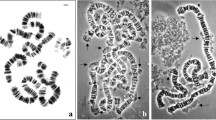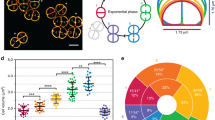Abstract
THE purpose of this communication is to describe an interesting property of the macronucleus of a species of Spirostomum, a large freshwater ciliate. The nuclear apparatus of this animal consists of a long cylindrical macronucleus and a number of small micronuclei. The cytology of this species has been described by Seshachar and Padmavathi1. Feulgen preparations show a number of granules of varying sizes in the macronucleus embedded in a more homogeneous matrix.
This is a preview of subscription content, access via your institution
Access options
Subscribe to this journal
Receive 51 print issues and online access
$199.00 per year
only $3.90 per issue
Buy this article
- Purchase on Springer Link
- Instant access to full article PDF
Prices may be subject to local taxes which are calculated during checkout
Similar content being viewed by others
References
Seshachar, B. R., and Padmavathi, P. B., J. Protozool., 3, 145 (1956).
Rudzinska, M., and Porter, K. R., J. Protozool., 2, 5 (1955), Supplement. Zebrun, W., ibid., 4, 22 (1957), Supplement.
Callan, H. G., and Tomlin, S. G., Proc. Roy. Soc., B, 137, 367 (1950).
Author information
Authors and Affiliations
Rights and permissions
About this article
Cite this article
SESHACHAR, B. The Macronucleus of Spirostomum. Nature 182, 1614–1615 (1958). https://doi.org/10.1038/1821614a0
Issue Date:
DOI: https://doi.org/10.1038/1821614a0
This article is cited by
-
Effect of Centrifugation on the Macro-nucleus of Spirostomum and Belpharisma
Nature (1960)
-
Two races of spirostomum from India
Die Naturwissenschaften (1959)
Comments
By submitting a comment you agree to abide by our Terms and Community Guidelines. If you find something abusive or that does not comply with our terms or guidelines please flag it as inappropriate.



